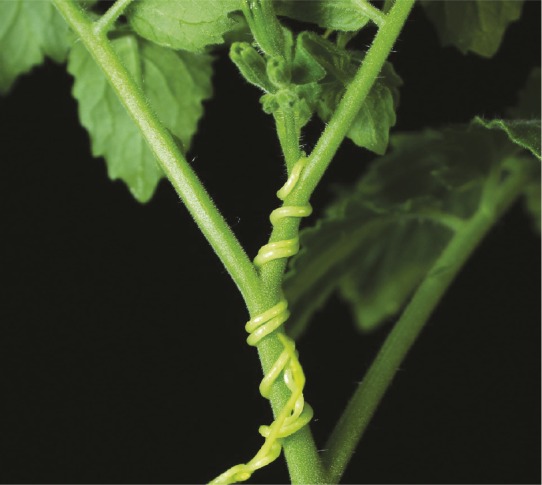Parasitic plant acts as plant signaling network

Rootless and leafless Cuscuta australis parasitizing a wild tomato plant.
Dodders, which are parasitic plants of the genus Cuscuta, form tendrils that coil around and penetrate host plant stems to obtain nutrients and water. The tendrils branch into vines that often bridge gaps between neighboring plants, creating host clusters connected by one or more Cuscuta plants. Christian Hettenhausen et al. (pp. E6703–E6709) demonstrate that Cuscuta bridges transmit ecological signals from insect-invaded plants to uninvaded plants, offering a benefit that may offset fitness costs to their hosts. Using transcriptomic and PCR analyses, the authors found that herbivore attacks on a parasitized host alter gene expression, resulting in elevated plant resistance to insects in both wounded and unwounded Cuscuta-bridged plants. The authors note that Cuscuta bridges among different hosts constitute a previously unreported type of signaling, whereby insect damage to a host induces large transcriptome rearrangements in connected but undamaged plants, allowing defensive metabolites to accumulate. Such signaling, which requires the plant hormone jasmonic acid, is conserved, rapid, and far-reaching, extending across several consecutively connected hosts and to distances of more than 100 cm, according to the authors. — T.J.
Amelioration of Alzheimer’s disease pathology
The accumulation of amyloid-β (Aβ) peptides in the brain contributes to the pathology of Alzheimer’s disease (AD), the most common cause of dementia worldwide. Inhibitors of the β-secretase BACE enzyme, key to the production of Aβ, are thought to help reduce cerebral Aβ levels. However, whether BACE inhibition can also repair brain circuits associated with AD remains unclear. Aylin Keskin et al. (pp. 8631–8636) used histochemistry, imaging techniques, and behavioral analyses to study BACE inhibition in a mouse model of AD. The mice, which exhibited severe cerebral Aβ pathology, neuritic and glial cytopathology, and learning and memory deficits, were fed either pellets containing the BACE inhibitor NB-360 or pellets that did not contain the inhibitor for 6–8 weeks. Following treatment with NB-360, the authors observed a substantial reduction of Aβ plaque deposition. In vivo two-photon calcium ion imaging revealed that NB-360 eliminated neuronal hyperactivity, a key characteristic of AD pathology in AD-like mouse models and humans with early AD. Moreover, compared with untreated mice, treated mice exhibited improved learning and memory in a maze task. According to the authors, the findings highlight the therapeutic potential of BACE inhibition for AD-like pathophysiological and cognitive impairments. — C.S.
Origins of Malagasy people

Traditional fishing pirogue from southeast Madagascar.
The Malagasy people of Madagascar exhibit dual African and Southeast Asian ancestry, as evidenced from cultural, linguistic, and genetic studies. When, where, and how these two ancestries combined remain contentious, especially in light of the central role ancestry plays in Malagasy society. Denis Pierron et al. (pp. E6498–E6506) collected genomic and mitochondrial DNA (mtDNA) from more than 2,700 individuals, on average 61 years of age, representing 257 villages across Madagascar. While mtDNA exhibits roughly equal contributions from African and Asian lineages, African lineages are much more frequent than Asian lineages in Y chromosomes, indicating a male bias in African ancestry. The ratio of African/Asian ancestry varies geographically, with Asian ancestry predominating in the Central Highlands and African ancestry more prevalent on the coasts. This suggests that admixture occurred heterogeneously across Madagascar, and therefore Asian and African populations initially colonized the island independently. The authors estimated admixture to have occurred relatively recently, between 500 and 900 years ago. However, further geographic clustering independent of African/Asian ancestry was also apparent, suggesting that geographic separation can produce detectable genetic differences in human populations within a few centuries, according to the authors. — B.D.
Evolutionary origin of embryo implantation
During human pregnancy, proinflammatory signaling primes the uterus for implantation, after which the endometrium shifts to an antiinflammatory state to prevent rejection of the fetus. However, the evolutionary origins of embryo implantation remain unclear. Oliver Griffith et al. (pp. E6566–E6575) report that implantation in eutherians, or placental mammals, likely evolved from an ancestral inflammatory reaction to embryo attachment. Using the opossum as a model, the authors present histological and transcriptomic analyses that reveal that a characteristic inflammatory response during pregnancy in marsupials corresponds to implantation in mice and humans. In addition, the authors found that the overlap between implantation in eutherian mammals and term pregnancy in the opossum extends beyond a few biomarkers to broad changes at the transcriptome level. The authors suggest that the inflammatory nature of implantation in eutherians evolved from an ancestral response to the embryo as a foreign body. Furthermore, the endometrial shift to a noninflammatory state represents a key evolutionary innovation necessary for increased gestation length and an extended period of placentation, according to the authors. — T.J.


